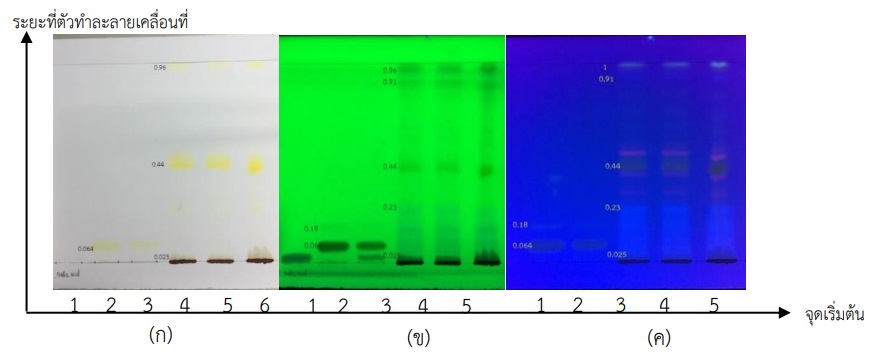องค์ประกอบทางพฤกษเคมีเบื้องต้น และฤทธิ์ต้านเชื้อรา Candida spp. ของสารสกัดใบหูกวางสีแดง
คำสำคัญ:
ใบหูกวางสีแดง, องค์ประกอบทางพฤกษเคมี, ฤทธิ์ต้านเชื้อราแคนดิดาบทคัดย่อ
การวิจัยนี้ มีวัตถุประสงค์เพื่อ 1) ศึกษาองค์ประกอบทางพฤกษเคมีเบื้องต้นของสารสกัดใบหูกวางสีแดงด้วยวิธีการสังเกตการเกิดสีและการตกตะกอน และเทคนิค Thin Layer Chromatography (TLC) และ 2) ศึกษาฤทธิ์ต้านเชื้อรากลุ่มแคนดิดา ด้วยวิธี Agar Disc Diffusion และวิธี Broth Microdilution โดยนำใบหูกวางสีแดงมาสกัดโดยการหมักด้วย 95% Ethanol และใช้เชื้อรา C. Albican ATCC 90028, C. Glabrata TISTR 5006, C. Kefyr TISTR 5270, C. Krusei TISTR 5256 และ C. Tropicalis TISTR 5045 วิเคราะห์ข้อมูลโดยใช้ค่าเฉลี่ยของค่า Rf และบริเวณยับยั้ง ทำการเก็บข้อมูลตั้งแต่เดือนธันวาคม 2561 ถึง สิงหาคม 2562 ผลการวิจัยพบว่า
1. ใบหูกวาง พบองค์ประกอบทางพฤกษเคมีเบื้องต้น 7 ชนิด ได้แก่ แอนทราควิโนนไกลโคไซด์ เทอร์พีนอยด์ ฟลาโวนอยด์ ซาโปนิน และแทนนิน เมื่อทดสอบด้วยเทคนิค TLC พบสาร Gallic Acid และ Quercetin
2. ผลการทดสอบฤทธิ์ต้านเชื้อรา Candida Spp. ด้วยวิธี Agar Disc Diffusion พบว่า สารสกัดใบหูกวางสีแดงมีฤทธิ์ต้านเชื้อรา C. Glabrata ได้ดีที่สุด รองลงมาคือ C. Kefry และ C. Krusei โดยมีค่าเฉลี่ย Inhibition Zone เท่ากับ 1.36, 1.10 และ 1.03 mm (SD=0.11, 0.05, 0.30 mm) ตามลำดับ เมื่อทดสอบด้วยวิธี Broth Microdilution มีค่า MIC เท่ากับ 7.81, 31.25 และ 62.50 ตามลำดับ และมีค่า MFC เท่ากับ 125, 125 และ >125 mg/ml ตามลำดับ
ดังนั้น ใบหูกวางสีแดงจึงสามารถนำไปพัฒนาเป็นผลิตภัณฑ์ต้านเชื้อราแคนดิดา สามารถเพิ่มทางเลือกในการรักษาให้กับผู้ป่วยได้
เอกสารอ้างอิง
Adnan, S. N. A., Ibrahim, N., & Yaacob, W. A. (2017). Disruption of Methicillin-Resistant Staphylococcus Aureus Protein Synthesis by Tannins. GERMS, 7(4), 186-192.
Ayoola, A. G., Coker, A. B. H., Adesegun, S. A., & Adepoju-Bello, A. (2008). Phytochemical Screening and Antioxidant Activities of Some Selected Medicinal Plants Used for Malaria Therapy in Southwestern Nigeria. Tropical Journal of Pharmaceutical Research, 7(3), 1019-1024.
Chatteeranan, S., & Niyomthai, S. (2013). Phytochemical Screening and Antioxidant Activity of Clerodendrum Disparifolium Leaves. KKU Sci Journal, 41(3), 723-730. (in Thai)
Huayhongthong, N. (2016). Phytochrmical Screening/Antioxidant Activity/- Glucosidaes/-Amylase. Chemical Education Faculty of Science, Burapha University. (in Thai)
Janwittayanuchit, I., & Rungsripanurud, W. (2013). Agents Microbacterial In Medical Microbiology, Bacteria. (pp. 434-436). Bangkok: Chulalongkorn University Press. (in Thai)
Lalam, R. (2020). Antimicrobial and Phytochemical Analysis of Methanolic Leaf Extracts of Terminalia Catappa Against Some Human Pathogenic Bacteria. Journal of Pharmacognosy and Phytochemistry 2020, 9(1), 1200-120.
Meis, J. F. G. M., & Verweij, P. E. (2001). Current Management of Fungal Infections. Drugs Journal, 61(1), 13-25.
Namwong, S. (2018). Antibacterial Activity of Terminalia Catappa L. Extract. Bangkok: Suan Sunandha Rajabhat University. (in Thai)
Pattaratanakorn, K., Boonchalaew, J., Chaipet, S., Seesad, S., Rattanakiat, S., & Laovachirasuwan, P. (2014). Development of Mouthwash from Phyllanthus Emblica L. Bark Extract for Oral Candidiasis. In The 5th Annual Northeast Pharmacy Research Conference of 2013 “Pharmacy Profession: Moving Forward to ASEAN Harmonization”. Faculty of Pharmaceutical Sciences. Khon Kaen University. (in Thai)
Pfaller, M. A., Moet, G. J., Messe, S. A., Jones, R. N., & Castanheira, M. (2010). Candida Bloodstream Infections: Comparison of Species Distributions and Antifungal Resistance Patterns in Community-Onset and Nosocomial Isolates in the SENTRY Antimicrobial Surveillance Program, (2008–2009). Antimicrobial Agents Chemother Journal, 55(2), 561-566.
Pimonrad, P., Whangchai, N., Suwanphakdee, S., & Sriyasak, P. (2017). Training Materials of Extracts Tannin form Terminalia Catappa Leaf: Easy Preparation Methods And Application in Ornamental Fish. Faculty of Fisheries, Maejo University. (in Thai)
Polpornpisit, A., Tungtrongpairoj, J., Chansue, N., Koeypudcha, W., Paphawasit, N., & Makato, E. (2006). The Study of Indian Almond Leaves (Terminalia Catappa L.) on Siamese Fighting Fish (Betta Splendens) and Guppy (Poecilia Reticulata) Diseases Treatment. Unpublished Manuscript, Faculty of Veterinary Science - Vet, Chulalongkorn University. (In Thai)
Polyiam, U. (2013). Chemical Composition and Biological Active of Ficus Hispida Linn. Unpublished Manuscript. Faculty of Science and Technology Rajamangala University of Technology Phra Nakhon. (In Thai)
Spampinato, C., & Leonardi, D. (2013). Candida Infections, Causes, Targets, and Resistance Mechanisms: Traditional and Alternative Antifungal Agents. BioMed Research International. Retrieved May 23, 2020 from https://www.ncbi.nlm.nih.gov/pmc/articles/PMC3708393/
Tantimavanich, S., Kitphiboonpun, W., & Prachayasittikul, V. (2018). Candida Auris: The First Resistant Candida. Journal of Med Tech Assoc Thailand, 46(2), 6472-6491. (In Thai)
Terças, A, G., Monteiro, A, S., Moffa, E, B., Santos, J, R. A., Sousa, E, M.., Pinto, A, R. B. et al. (2017). Phytochemical Characterization of Terminalia Catappa Linn. Extracts and Their Antifungal Activities Against Candida spp. US National Library of Medicine National Institutes of Health, 2017(8), 595.
Thatsanawichitphan, Y. (2014). Antimicrobial Activity Extracts from Piper Interruptum Opiz and Piper.
Chantaranothainianum C. Suwanp. & D. A. Simpson. A Dissertation Submitted in Partial Fulfillment of the Requirement for the Master of Education Degree in Science Education, Kanchanaburi Rajabhat University. (in Thai)
Tummarongkongkongsatit, A., & Rojtinnakorn, J. (2007). Effective of Thai Herbs Extracts to Inhibit Bacterial Pathogens in Giant Freshwater Prawn (Macrobrachium Rosenbergii). Journal of Fisheries Technology Research, 1(2), 192-200. (in Thai)
Udomkhamsuk, W., & Sanmanowong, P. (2007). Enhancing Knowledge of Care for Oral Candidiasis Infection among Persons with HIV and Familty Members. KKU Research Journal, 12(4), 465-471. (in Thai)
Vazquez, J. A., Peng, G., Sobel, J. D., Steele-Moore, L., Schuman, P., Holloway, W. & et al. (2001). Evolution of Antifungal Susceptibility among Candida Species Isolates Recovered from Human Immunodeficiency Virus-Infected Women Receiving Fluconazole Prophylaxis. Clinical Infectious Diseases, 33(7), 1069-1075.
Wongsatit, C. (2018). Botanist Department of Pharmaceutical Botany, Faculty of Pharmacy. Mahidol University. (Personal Communication, October 24, 2018)
Yamim, K., Chlard, C., & Penprapai, N. (2001). Substance Properties of Terminalia Catappa Leaf for Inhibit Bacteria Aeromonas hydrophila. Faculty of science and fisheries, Technology Rajamangala University. (in Thai)
Yang, B., Kortesniemi, M., Liu, P., Karonen, M., & Salminen, J. P. (2012). Analysis of Hydrolysabletannins and Other Phenolic Compounds in Emblic Leaf Flower (Phyllanthus Emblica L.) Fruits by High Performance Liquid Chromatography - Electrospray Ionization Mass Spectrometry. Journal of Agriculture and Food Chemistry, 60(35), 8672-8683.
Yuenyaow, L., & Wansutha, S. (2018). Anti-Candida Albicans of Probiotic. Journal of Traditional Thai Medical Research, 4(2), 1-20. (in Thai)

ดาวน์โหลด
เผยแพร่แล้ว
ฉบับ
ประเภทบทความ
สัญญาอนุญาต
1. บทความหรือข้อคิดเห็นใด ๆ ที่ปรากฏในวารสารเครือข่าย วิทยาลัยพยาบาลและการสาธารณสุขภาคใต้ ที่เป็นวรรณกรรมของผู้เขียน บรรณาธิการหรือเครือข่ายวิทยาลัยพยาบาลและวิทยาลัยการสาธารณสุขภาคใต้ ไม่จำเป็นต้องเห็นด้วย
2. บทความที่ได้รับการตีพิมพ์ถือเป็นลิขสิทธิ์ของ วารสารเครือข่ายวิทยาลัยพยาบาลและการสาธารณสุขภาคใต้







